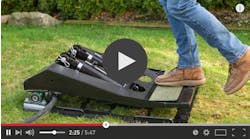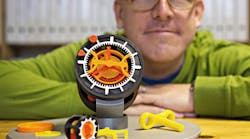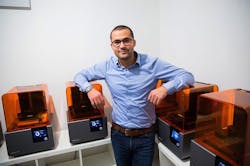When the spindle broke off his wife's sewing machine, Michael Sorkin refused to replace the device. Instead, he bought a 3D printer and built the part himself.
Four years later, he's using the technology to change how to make the Swiss watch you might get for Christmas.
On a rainy afternoon in Sorkin's company's dimly lit office in central Berlin, an employee in a white lab coat checks on the progress of six cubes tinted in see-through orange. A laser silently slices resin, layer by layer. Formlabs' product: 3D printers. Interested customers include Swiss watchmakers and jewelers, which are quietly testing the process's potential.
"If you don't concern yourself with new technology, you'll lose out," said Sorkin, Formlabs Europe's managing director, as he pointed to printed models of figurines used in movies and rings used by jewelers spread out on a table in a conference room. "We are disrupting an industry that hasn't changed in centuries, and bringing fresh wind into it."
The technology is also starting to be deployed in the Swiss chocolate industry, though it's less far along. Nestle SA, the world's biggest food company, uses 3D printing in research into prototypes for chocolate confectionery and says it's interested in going further. Zurich-based Barry Callebaut AG, which makes almost a quarter of the world's chocolate and supplies Unilever with chocolate for its Magnum ice cream brand, is testing new ways of decorating and forming chocolate in its gourmet business.
For the makers of Swiss watches, embroiled in the most challenging times since the introduction of battery-powered timepieces in the 1970s, new technologies could help speed up manufacturing while containing costs. Declining demand in Asia has spread to Europe and the U.S. this year, leading companies including Richemont to cut jobs, buy back unsold inventory from retailers and refocus on more affordable pieces.
About 64% of more than 50 watch executives surveyed by Deloitte this year said they already use 3D printing for prototypes. Swatch Group AG says the technology is deployed for multiple uses. TAG Heuer uses it for models of buckles and crowns. Romain Jerome, whose mechanical timepieces cost as much as 200,000 Swiss francs ($194,000), has enlisted 3D companies Zedax and i.materialise to print its prototypes of cases, dials and bracelets.
Richemont, owner of the Cartier and Montblanc brands, sponsors a research chair at Lausanne's polytechnical university that studies micro-manufacturing technologies, including 3D printing. Montblanc, which has been using it for about three years now to make prototypes, is looking to replace some of the older printers as the technology is advancing fast.
Formlabs Europe Managing Director Michael Sorkin in his Berlin offices.
Photographer: Krisztian Bocsi/Bloomberg
"It's the quickest and best way of having a very precise indication of the volume and shape of any given part," Davide Cerrato, head of Montblanc's watch business, said by phone. "It takes just a few hours to get the outcome, so you can quickly see if what you're drawing also works in 3D. It's very precise, and it's very close to the final product."
Here's everything you need to know about 3D printing:
In 3D printing, objects are designed on a computer. A connected printer reads the file, then heats up the material of choice—from specialized plastic to metal to chocolate—to the point where it melts to a hot wax-like consistency. Then, it shoots out layer upon layer through a heated nozzle in the specified shape. The process can cut down the time and effort in crafting desired products, while expanding design possibilities that may be too intricate for human hands.
Richemont Chairman Johann Rupert said in November that the company needs to be more flexible, adding that may involve completely new innovative production methods that the group already has in some of its "secret labs." He didn't specify whether they were related to 3D printing.
The impact the technology would have on the price tag of the timepieces could go both ways, according to Yves Bellouard, who holds Richemont's chair in multi-scale manufacturing technologies at the Federal Institute of Technology in Lausanne.
"A personalized watch—a certain type of watch for one single person—would certainly be added value, and people would buy it for that, so the price could go up," Bellouard said. "Simplified manufacturing by reducing the number of components could also make it cheaper in certain aspects."
TAG Heuer Chief Executive Officer Jean-Claude Biver says the transition is still at the beginning stages.
"Today, it's more part of accessories," Biver said by phone. "But we're on the way. You should never laugh at technology. There are many things that nobody would've thought possible—like that we'd walk on the moon someday."
It may take time before watchmakers print an entire watch. The equipment and materials can be pricey, and completely printed timepieces could hit resistance from customers who prefer handmade craftsmanship and quality, said Romain Jerome Chief Executive Officer Manuel Emch.
"Customers are increasingly looking for bespoke and unique pieces," Emch said in a phone interview. "There's still a high barrier to integrate the elements of rapid manufacturing and prototyping into the world of hand-made craftsmanship."
Somerville, Massachusetts-based Formlabs is trying to break down those silos. Its European unit in Berlin sells thousands of 3D printers a year across all industries, including watchmaking, jewelry and dental. Switzerland is its fifth-biggest market in Europe and the biggest for printers shipped to watchmakers and jewelers.
Swiss chocolate may be next. Barry Callebaut's chocolate factory—the world's largest— is a pioneer. It's located in Wieze, Belgium, a picturesque rural village where brick houses with steep shingle roofs and tidy front lawns line the streets. The smell of chocolate envelops the neighborhood.
Here, Pascale Meulemeester, the global head of Barry Callebaut's gourmet business, has spent the past two years with partner Byflow looking into 3D printing of chocolate. While the company is still working on prototypes, in 2018 it plans to start selling its first printer cartridges, which may be filled with customized chocolate pearls that melt quickly. Initially, buyers will include chefs and chocolate makers. Bigger customers across Europe and Asia, especially in China, have also expressed interest in the technology, she said.
"It can be a game-changer for companies," Meulemeester said in a conference room above Barry Callebaut's Chocolate Academy, where masters in white jackets train fellow chefs and chocolatiers. "They could offer instant, personalized chocolate to consumers either through a machine or through us as a service to our customers."
Because of the complex and delicate characteristics of chocolate, it's been an industry slow to adapt to the new technology. The biggest hurdle is the fact that chocolate has to be tempered in order to be formed, which means changing its stable crystals by constant movement at specific temperatures.
Alexandre Bourdeaux, executive pastry chef at Barry Callebaut, demonstrated in the big kitchen on one of six granite-top tables that cooled the chocolate, tempering the brown stuff with pallets and spatulas. It can take as long as an hour, he said. At the moment, the only way to print chocolate is to go through this process, fill a syringe and use the mass while it's in the necessary condition.
With the chocolate cartridge and Byflow's printer—being developed specifically for Barry Callebaut—the plan is to have the machine do the whole procedure, from pushing the print button to a printed chocolate product in as little as a few minutes.
"Millennials want things to be instant and personalized, so they will be the first ones moving this new opportunity forward," Meulemeester said.
In Hedingen, a quiet village outside Zurich, an engineer is pushing the frontiers of what's possible for watches. Christoph Laimer, who started out 3D printing Legos for his children, has printed one of the most complicated features in a timepiece. In a workshop in his basement, Laimer this year made his own tourbillon—a spinning mechanism that's one of the most complicated features in a timepiece—using a 2,500-franc desktop printer.
While the end product, in orange, red and black plastic materials, only runs for about 30 minutes after being wound, it demonstrates the potential for professional watchmakers who are willing to invest in industrial printers capable of printing metal, at a cost of more than $100,000. Finding no practical use, Laimer's watch sits on a wooden table in the basement, along with other experiments he has printed, such as a wall clock and an electrical motor.
"In the watch world, it's the gold standard," Laimer said. "It's not comparable with a real wristwatch, but the technology is only going to get better."
by Corinne Gretler, Bloomberg











